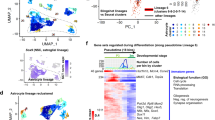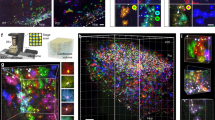Summary
Disaggregated cells of newborn DBA/1J mouse neopallium were grown in colony cultures, and colonies of cells at various stages of differentiation along the astrocyte cell lineage were examined after 3 days, 1, 2 and 4 weeks by electron microscopy and by NBD-phallacidin which demonstrates the distribution of microfilaments. The earliest astrocyte precursor cells or glioblasts are closely apposed epithelial cells that rarely have junctions. Their scanty cytoplasm contains many free ribosomes but few microfilaments. The cells in the next stages of astrocyte lineage or proastroblasts are flat and are separated from each other to a variable degree. They have intercellular junctions associated with microfilaments and contain singly dispersed intermediate filaments. The proastroblasts gradually differentiate into astroblasts which have a similar morphology except that in addition to the singly distributed intermediate filaments they also contain intermediate filaments arranged into bundles of various sizes. The mature fibrous astrocytes have well-defined processes and distinct perikarya. They form from astroblasts in culture and also contain numerous bundles of intermediate filaments. The dibutyryl-cyclic AMP (dBcAMP)-induced astrocytes in culture in contrast are large stellate cells similar to reactive astrocytes found around sites of injury in the brain. On the basis of these and previous immunocytochemical studies of the formation and distribution of intermediate filaments in the cytoplasm of differentiating astrocytes, criteria are proposed for identification of different cells along the astrocyte lineage.
Similar content being viewed by others
References
Barak, L. S., Yocum, R. R., Northnagel, E. A. &Webb, W. W. (1980) Fluorescence staining of the actin cytoskeleton in living cells with 7-nitrobenz-2oxa-1,3-diazole phallacidin.Proceedings of the National Academy of Sciences USA 77, 980–4.
Bignami, A. &Dahl, D. (1977) Specificity of the glial fibrillary acidic protein for astroglia.Journal of Histochemistry and Cytochemistry 25, 466–9.
Connolly, J. A., Kalnins, V. I. &Barber, B. H. (1981) Microtubules and microfilaments during cell spreading and colony formation in PK15 epithelial cells.Proceedings of the National Academy of Sciences USA 78, 6922–6.
Dahl, D., Ruegar, D. C., Bignami, A., Weber, K. &Osborn, M. (1981) Vimentin, the 57 000 molecular weight protein of fibroblast filaments is the major cytoskeletal component of immature glia.European Journal of Cell Biology 24, 191–6.
DeArmond, S. J., Siegel, M. W., Dixon, R. G. &Eng, L. F. (1981) Post-embedding immunoperoxidase staining of glial fibrillary acidic protein for light and electron microscopy.Journal of Neuroimmunology 1, 3–15.
Fawcett, D. W. &McNutt, N. S. (1969) The ultrastructure of the cat myocardium. I. Ventricular papillary muscle.Journal of Cell Biology 42, 1–45.
Fedoroff, S. (1977) Tracing glial cell lineages by colony formation in primary cultures. InCell, Tissue and Organ Cultures in Neurobiology (edited byFedoroff, S. &Hertz, L.), pp. 215–21. New York: Academic Press.
Fedoroff, S. (1978) The development of glial cells in primary cultures. InDynamic Properties of Glial Cells (edited bySchoffeniels, E., Franck, G., Hertz, L. &Towers, D. B.), pp. 83–92. New York: Pergamon Press.
Fedoroff, S. (1980) Tracing the astrocyte cell lineage in mouse neopalliumin vitro andin vivo. InTissue Culture in Neurobiology (edited byGiacobini, E., Vernadakis, A. &Shahar, A.), pp. 349–72. New York: Raven Press.
Fedoroff, S. &Doering, L. C. (1980) Colony culture of neural cells as a method of the study of cell lineages in the developing CNS: The astrocyte cell lineage.Current Topics in Developmental Biology 16, 283–304.
Fedoroff, S. &Hall, C. (1979) Effect of horse serum on neural cell differentiation in tissue culture.In Vitro 15, 641–8.
Fedoroff, S., White, R., Neal, J., Subrahmanyan, L. &Kalnins, V. I. (1983) Astrocyte cell lineage: II. Mouse fibrous astrocytes and reactive astrocytes in cultures have vimentin and GFP containing intermediate filaments.Developmental Brain Research 7, 303–15.
Gordon, W. E. &Bushnell, A. (1979) Immunofluorescent and ultrastructural studies of polygonal microfilament networks in respreading non-muscle cells.Experimental Cell Research 120, 335–48.
Hertz, E. &Hertz, L. (1979) Polarographic measurement of oxygen uptake by astrocytes in primary cultures using the tissue culture flask as the respirometer chamber.In Vitro 15, 429–36.
Imamoto, K., Paterson, J. A. &Leblond, C. P. (1978) Radioautographic investigation of gliogenesis in the corpus callosum of young rats. I. Sequential changes in oligodendrocytes.Journal of Comparative Neurology 180, 115–38.
Ireland, G. W. &F. C. T. Voon (1981) Polygonal networks in living chick embryonic cells.Journal of Cell Sciences 52, 55–69.
Jones, A. L. &Fawcett, D. W. (1966) Hypertrophy of the agranular endoplasmic reticulum in hamster liver induced by phenobarbital.Journal of Histochemistry and Cytochemistry 14, 215–32.
Juurlink, B. H. J., Fedoroff, S., Hall, C. &Nathaniel, E. J. H. (1981) Astrocyte Cell lineage. I. Astrocyte progenitor cells in mouse neopallium.Journal of Comparative Neurology 200, 375–91.
Kaltenbach, J. P., Kaltenbach, M. H. &Lyons, W. B. (1958) Nitrosin as a dye for differentiating live and dead ascites cells.Experimental Cell Research 15, 112–7.
Kimelberg, H. K., Narumi, S. &Bourke, R. S. (1978) Enzymatic and morphological properties of primary rat brain astrocyte cultures, and enzymatic developmentin vivo.Brain Research 153, 55–77.
Korinkova, P. &Lodin, Z. (1977) A transitional differentiation of glial cells of cultured corpus callosum caused by dibutyryl cyclic adenosine monophosphate.Neuroscience 2, 1103–14.
Korr, H. (1980) Proliferation of different cell types in the brain.Advances in Anatomy, Embryology and Cell Biology 63, 1–72.
Lazarides, E. (1976) Actin, α-actinin, and tropomyosin interaction in the structural organization of actin filaments in nonmuscle cells.Journal of Cell Biology 68, 208–19.
Leblond, C. P. (1972) Growth and renewal. InRegulation of Organ and Tissue Growth (edited by Goss, R. J.), pp. 13–9. New York: Academic Press.
Levitt, P., Cooper, M. L. &Rakic, P. (1981) Co-existence of neuronal and glial precursor cells in the cerebral ventricular zone of the fetal monkey: an ultrastructural immunoperoxidase analysis.Journal of Neuroscience 1, 27–39.
Levitt, P. &Rakic, P. (1980) Immunoperoxidase localization of glial fibrillary acidic protein in radial glial cells and astrocytes of the developing Rhesus monkey brain.Journal of Comparative Neurology 193, 815–40.
Lim, R., Mitsunobu, K. &Li, W. K. P. (1973) Maturation stimulatory effect of brain extract and dibutyryl cyclic AMP on dissociated embryonic brain cells in culture.Experimental Cell Research 79, 243–6.
Lim, R., Troy, S. &Turiff, D. E. (1977) Fine structure of cultured glioblasts before and after stimulation by a glia maturation factor.Experimental Cell Research 106, 357–72.
Ling, E. A., Paterson, J. A., Privat, A., Mori, S. &Leblond, C. P. (1973) Investigation of glial cells in semithin sections. I. Identification of glial cells in the brain of young rats.Journal of Comparative Neurology 149, 43–72.
Manthorpe, M., Adler, R. &Varon, S. (1979) Development, reactivity and GFA immunofluorescence of astroglia-containing monolayer cultures from rat cerebrum.Journal of Neurocytology 8, 605–21.
McCarthy, G. F. (1981) Glial cell proliferation in the corpus callosum of young adult mice.Proceedings of the Canadian Federation of Biological Societies 24, 237.
Messier, P. E. &Auclair, C. (1974) Effect of cytochalasin B on interkinetic nuclear migration in the chick embryo.Developmental Biology 36, 218–23.
Moonen, G., Cam, Y., Sensenbrener, M. &Mandel, P. (1975) Variability of the effects of serum-free medium, dibutyryl-cyclic AMP or theophylline on the morphology of cultured newborn rat astroblasts.Cell and Tissue Research 163, 365–72.
Moonen, G., Heinan, E. &Goessens, G. (1976) Comparative ultrastructural study of the effects of serum-free medium and dibutyryl-cyclic AMP on newborn rat astroblasts.Cell and Tissue Research 167, 221–7.
Mori, S. &Leblond, C. P. (1969) Electron microscopic features and proliferation of astrocytes in the corpus callosum of the rat.Journal of Comparative Neurology 137, 197–226.
Murkerji, S. &Hertz, L. (1976) Oxygen uptake by normal glial cells cultured under different conditions.Transactions of the American Society of Neurochemistry 7, 90.
Paterson, J. A., Privat, A., Ling, E. A. &Leblond, C. P. (1973) Investigation of glial cells in semithin sections. III. Transformation of subependymal cells into glial cells as shown by radioautography after [3H]thymidine injection into the lateral ventricle of the brain of the young rat.Journal of Comparative Neurology 149, 83–102.
Peters, A., Palay, S. L. &Webster, H. De F. (1976)The Fine Structure of the Nervous System: The Neurons and Supporting Cells. Philadelphia, London, Toronto: W. B. Saunders.
Privat, A. (1978) Morphological approaches to the problems of neuroglia. Some comments. InDynamic Properties of Glial Cells (edited bySchoffeniels, E., Franck, G., Hertz, L. &Tower, D. B.), pp. 55–64. Oxford, New York, Toronto, Sydney, Paris, Frankfurt: Pergamon Press.
Privat, A. &Fulcrand, J. (1977) Neuroglia from subventricular percursor to the mature cell. InCell, Tissue and Organ Cultures in Neurobiology (edited byFedoroff, S. &Hertz, L.), pp. 11–37. New York: Academic Press.
Richardson, K. C., Jarett, L. &Finke, E. N. (1960) Embedding in epoxy resins for ultrathin sectioning in electron microscopy.Stain Technology 35, 313–23.
Schachner, M., Hedley-White, E. T., Hsu, D. W., Schoomaker, G. &Bignami, A. (1977) Ultrastructural localization of glial fibrillary acidic protein in mouse cerebellum by immunoperoxidase labeling.Journal of Cell Biology 75, 67–73.
Schnitzer, J., Franke, W. W. &Schachner, M. (1981) Immunocytochemical demonstration of vimentin in astrocytes and ependymal cells of developing and adult mouse nervous system.Journal of Cell Biology 90, 435–47.
Schnitzer, T. &Schachner, M. (1980)In vivo andin vitro expression of vimentin in mouse nervous system at different developmental stages.European Journal of Cell Biology 22, 440.
Schousboe, A. (1980) Primary cultures of astrocytes from mammalian brain as a tool in neurochemical research.Cell Morphology and Biology 26, 505–13.
Sensenbrenner, M., Dvilliers, G., Bock, E. &Porte, S. (1980) Biochemical and ultrastructural studies of cultured rat astroglial cells: Effect of brain extract and dBcAMP on glial fibrillary acidic protein and glial filaments.Differentiation 17, 51–61.
Shapiro, D. L. (1973) Morphological and biochemical alterations in foetal rat brain cells cultured in the presence of monobutyryl cyclic AMP.Nature 241, 203–4.
Sharp, G., Osborn, M. &Weber, K. (1982) Occurrence of two different intermediate filament proteins in the same filamentin situ within a human glioma cell line.Experimental Cell Research 141, 385–95.
Shaw, G., Osborn, M. &Weber, K. (1981) An immunofluorescence microscopical study of the neurofilament triplet proteins, vimentin and glial fibrillary acidic protein within the adult rat brain.European Journal of Cell Biology 26, 68–82.
Skoff, R. R., Price, D. L. &Stocks, A. (1976) Electron microscopic autoradiographic studies of gliogenesis in rat optic nerve. I. Cell proliferation.Journal of Comparative Neurology 169, 291–311.
Staehelin, L. A. (1974) Structure and function of intercellular junctions.International Review of Cytology 39, 191–283.
Sturrock, R. R. (1976) Light microscopic identification of immature glial cells in semithin sections of the developing mouse corpus callosum.Journal of Anatomy 122, 521–37.
Sturrock, R. R. (1982) Cell division in the normal central nervous system. InAdvances in Cellular Neurobiology (edited byFedoroff, S. &Hertz, L.), pp. 3–33. New York, London: Academic Press.
Tapscott, S. J., Bennett, G. S. &Holtzer, H. (1981a) Neuronal precursor cells in the chick neural tube express neurofilament proteins.Nature 292, 836–8.
Tapscott, S. J., Bennett, G. D., Toyama, Y., Kleinbart, F. &Holtzer, H. (1981b) Intermediate filament proteins in the developing chick spinal cord.Developmental Biology 86, 40–54.
Tardy, M., Fager, C., Rolland, B., Bardakdjian, F. & Gonnard, P. (1981) Effect of prostaglandins and dibutyryl cyclic AMP on the morphology of cells in primary astroglial cultures and on metabolic enzymes of GABA and glutamate metabolism.Experientia 37, 19–21.
Trimmer, P. A., Reier, P. J., Oh, T. H. &Eng, L. F. (1982) An ultrastructural and immunocytochemical study of astrocytic differentiationin vitro.Journal of Neuroimmunology 2, 235–60.
Vaughn, J. E. (1969) An electron microscope analysis of gliogenesis in rat optic nerves.Zeitschrift für Zellforschung und mikroskopische Anatomie, Abteilung Histochemie 94, 293–324.
Yen, S. H. &Fields, K. L. (1981) Antibodies to neurofilaments, glial filaments and fibroblast-intermediate filament-proteins bind to different cell types of the nervous system.Journal of Cell Biology 88, 115–26.
Author information
Authors and Affiliations
Rights and permissions
About this article
Cite this article
Fedoroff, S., Neal, J., Opas, M. et al. Astrocyte cell lineage. III. The morphology of differentiating mouse astrocytes in colony culture. J Neurocytol 13, 1–20 (1984). https://doi.org/10.1007/BF01148315
Received:
Revised:
Accepted:
Issue Date:
DOI: https://doi.org/10.1007/BF01148315




